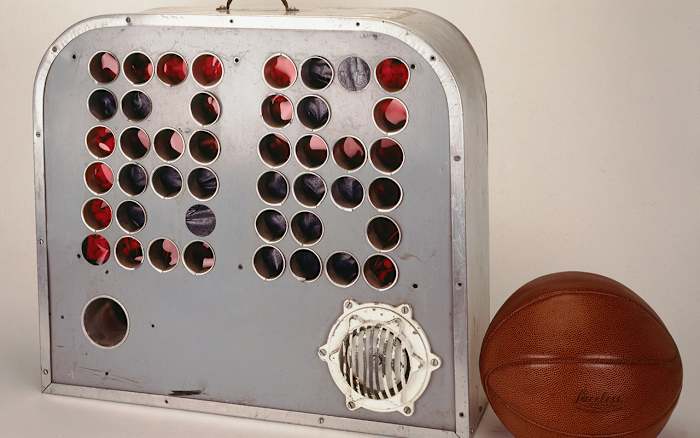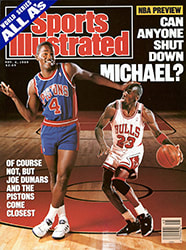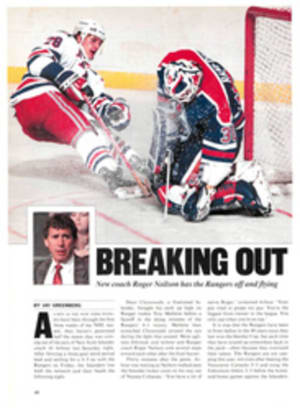In the Nick of Time
The heartbeat of the game is shown on the digital display above the backboard, the numbers changing each second. How much time? The question is perpetually asked by everyone watching or playing. The clock always gives the answer.
"24 seconds...
"23...
"22...."
If the game has become a dance, a ballet for big men, then this is the tempo. The rhythm is in the numbers. There never is the luxury of base-ball's contemplative dugout life, with all that time to reflect and chew sunflower seeds and bubble gum and stringy wads of tobacco. No huddles. No conversations with caddies. Time always presses the action. Go. Move. Do. The numbers move lower and lower, down to single digits. Single digits? Already?
"3 seconds...
"2...
"1...
"0...."
A grim buzzer and failure await the tardy. Twenty-four seconds to shoot. No more. Never. The equipment is as basic to the professional game as ball and rim, net and court and moon-boot sneakers. An alarm clock is in charge, every foot running on a swift conveyor belt.
The alarm clock is 35 years old. Happy birthday, alarm clock.
"I wasn't looking for any particular time," Danny Biasone says. "I was just looking for a number. Any number. Twenty-four seconds is what came out."
He is 80 years old and still spends most of his days at the bowling alley he has owned for most of his adult life in the Eastwood section of Syracuse, N.Y. In 1954 he also owned the Syracuse Nationals in the NBA. He did not have the money that the owners of some other franchises had, but he shared with them a great unease about what had developed in their game. He sometimes thought he owned a still-life painting instead of a basketball team.
The strategy of the day had become inaction. Get a lead. Hold the ball. Go to the foul line. Make the foul shots. Teams were deciding to stall earlier and earlier in the game, especially if they were underdogs. The low point had been reached on Nov. 22, 1950, when Fort Wayne Piston coach Murray Mendenhall had his team hold the ball for most of the game to defeat the Minneapolis Lakers 19-18. The score at the end of the first period was 8-7, Pistons. The crowd was enraged.
Biasone felt that there had been enough talk about the problem. What to do? Various rule changes had been tried. None had worked. He developed his own idea: The shot clock. "Teams were taking about 60 shots in a game if nobody screwed around," Biasone says. "I figured if the teams combined for 120 shots in a game and the game was 48 minutes long....
I divided 120 shots into 2,880 seconds, I believe. The answer was 24."
There were no grand tests with wind tunnels at the Massachusetts Institute of Technology, no experiments with white mice. Biasone simply persuaded the other league owners to come to Vocational High in Syracuse for a summertime demonstration. He scrimmaged some players from his team against some other players who lived in the area. Haskell Cohen, then the league's publicity director, kept track of the time and called out when the 24 seconds had elapsed. The owners liked the idea and agreed to try the rule in the exhibition season. It worked so well in the exhibitions that it was immediately adopted for the 1954-55 regular season.
"I remember Red Auerbach sat us down before the first game with the clock and said, 'Don't think about it,' " Boston Celtics Hall of Fame guard Bob Cousy says. "He told us to just go out and play our game naturally. And we did. I don't think we were called two times in the entire season for not getting a shot off within 24 seconds."
The game suddenly had a wonderful amount of free air. Cousy had been one of the major weapons before the clock was added. With six minutes left, sometimes even eight minutes, Auerbach had handed him the ball and told him to start dribbling. He had spent a lifetime on the foul line.
"I bet I lost about 10 points a game from the foul line because of that rule, but it also probably prolonged my career," Cousy says. "The fouls were getting worse and worse. Guys would really hit you. Paul Hoffman [of the Baltimore Bullets] literally tackled me once, he was so frustrated. The clock opened everything up."
The early clocks sat on the floor in most arenas, often obscured by photographers and fans. Defenders found ways to put their bodies between dribblers and the clock. How much time? Malfunctions happened often—customers tripping over wires on the way to courtside seats. The NBA was much more like a traveling circus in those days, and the clock was one of the oddities that came along with the show.
"You played all over. It was the home team's responsibility to provide the clocks, even on a neutral floor," says Marty Blake, publicity man for the old Milwaukee Hawks. "I had two clocks, three bags of wires. It took up a whole cab. One night Minneapolis and Philadelphia played in Chicago, and I came down from Milwaukee to run the clocks for them. I had the bags of wires, the boxes, the whole thing. So I get there. Somebody forgot to bring the balls."
The number of controversies generated by the rule was low. Who can argue with an alarm clock? The only complaints were with the man who ran the clock. He would sit with his finger poised over the reset button, waiting for a shot to hit the backboard or rim or go through the basket. Sometimes visiting coaches would find the home finger slow when the home team got the ball.
"I think there used to be some slow-fingered timers in the league, but even that stopped," Utah Jazz president Frank Layden says. "You know why? The world of gambling won't let that happen. Point spreads are too sacred. The oddsmakers wouldn't tolerate slow clocks. With the taping of games and everything now, I'll bet they test the clocks all the time."
Teams tried little strategies, like bouncing the ball off the backboard to reset the clock, but they soon found that the best strategy was to keep playing. If the clock was winding down, a man simply had to free himself and take a shot. One-on-one. The roads that Michael Jordan would travel were established. All he had to do was be born.
"I look at films of the old games, and they look like slow motion," says Buddy Jeannette, who coached the 1947-48 champion Baltimore Bullets of the Basketball Association of America, an NBA precursor. "We took our time back then."
The highest-scoring team in the league in 1947-48 was the Chicago Stags (75.8 points per game). The NBA average in the '54-55 season was 92.6.
"The amazing thing to me is that no one has tampered with the number," Biasone says. "It's still the same. Twenty-four seconds."
Other numbers have been appropriated by other levels of the game. In college ball the men have a 45-second clock and the women have a 30-second clock. The international amateur game has a 30-second clock. The professionals have kept 24, institutionalizing it, covering it with a certain amount of moss, making it a familiar number. The NBA. The 24-second clock.
"It's one of those intrinsically perfect, wonderfully illogical, perfectly imperfect numbers, like nine innings in baseball and 18 holes in golf," says broadcaster Mike Newlin, a former NBA guard. "It's an orphan number that fits perfectly into the family of basketball. I know. I've played the game, and 24 seconds is perfect, providing just enough comfort to get off the shot."
The clocks have been modernized, taken to the top of the backboards, where players, coaches and fans can read them. The wires have been tactfully hidden. The timekeepers sometimes have more arguments with the home-team coaches than with the visitors. "I get 25 dollars per game," Atlanta clock operator Bruce Bell says, "and [Hawk coach] Mike Fratello's yelling, 'Remember where your check's coming from.' Like that's important to me."
There have been modifications around the basic rule—the latest one, established this year, eliminates the five-second reset when a ball goes out of bounds; if one second is left when a ball goes out without a change of possession, one second is all the inbounding team gets—but the heartbeat invented by Biasone remains.
"If a team is good offensively, the clock doesn't come into play much," says Sacramento Kings coach Jerry Reynolds. "But it's kind of a myth that you can get a shot anytime you want. With teams that aren't good offensively or don't have good one-on-one players, the 24-second clock is a factor. If you can get the ball to Michael Jordan with six seconds left, there isn't much worry about getting a shot. Get it to some of the players that we've had and you worry."
"I remember coaching in Phoenix and being behind Boston by 26 points at halftime," says Dallas Maverick coach John MacLeod. "We came back and won, but we'd never have done it without the 24-second clock. I've been up 20 and blown it too, but in this instance we trailed the whole game. Charlie Scott got the last shot and made it, and we won."
"Overall, it's been great," says swingman Robert Reid of the Portland Trail Blazers. "Especially in the playoffs, when each possession is more valuable. The shot clock makes the game wide open, gives the NBA a mystique."
Twenty-four seconds. The conveyor belt rolls. If reading this story has taken you three minutes, the clock has already forced at least seven shots and is clicking toward an eighth.
"3 seconds...
"2...
"1...."
"When you sit up in the stands, it seems like just some guy pushing a button," says Barry Liebowitz, who became the clock operator for the Washington Bullets last year. "The first five games, I was so nervous. I was a wreck. I couldn't enjoy the game. I was going home with headaches because I was stiff and tense from watching the ball. The whole universe was focused in on that ball. I was so worried about making a mistake....
Have you ever had Wes Unseld looming over you?"
"24...
"23...
"22...."
"I'll be watching the games on television," Biasone says. "I like to watch the games."
Happy birthday, alarm clock.
ILLUSTRATION
ED SOREL
ILLUSTRATION
ED SOREL
COUSY WAS SO MASTERFUL AT DRIBBLING OUT THE CLOCK THAT HOFFMAN ONCE TACKLED HIM OUT OF FRUSTRATION
ILLUSTRATION
ED SOREL
BIASONE MAY NOT HAVE BEEN A LATIN SCHOLAR, BUT HE AND HIS FELLOW NBA OWNERS UNDERSTOOD THAT FORTUNE FAVORS THE BRAVE


